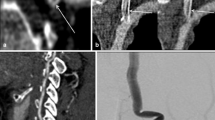Abstract
Purpose.
Conventional digital subtraction angiography (DSA) still represents the criterion standard for the diagnosis of vertebral artery dissection (VAD), but the main drawbacks of this technique include invasiveness, patient discomfort and risk of complications. We evaluated the potential of multidetector computed tomography angiography (CTA) as a noninvasive tool providing highresolution images of the arterial lumen and wall by comparing the diagnostic accuracy of CTA and colour-Doppler ultrasonography (CDUS) in detecting acute VAD.
Materials and methods.
We retrospectively reviewed 15 cases of VAD in 15 patients (five men and ten women, age range 28–58 years) who came to our attention between August 2001 and September 2005. The diagnosis was made on the basis of appropriate clinical presentation, absence of atherosclerotic disease in the cerebrovascular circulation and evidence of distinctive CT features, which were subsequently confirmed by conventional angiography used as reference standard. All patients with a clinical suspicion of VAD underwent CDUS of the neck vessels prior to CTA. Accuracy, sensitivity and specificity of CDUS and CTA were expressed as percentages of agreement with the reference angiographic procedure. Interreader concordance for detection of VAD by CTA was calculated with the Cohen K value.
Results.
The CDUS examinations revealed ten out of 15 VAD, with a sensitivity of 66%, a specificity of 60%, a positive predictive value of 55.5% and a negative predictive value of 70.5%. In five cases, CDUS revealed nonspecific wall and flow alterations; in eight patients, high resistance obstructive flow; and in two patients, intimal flap with demonstration of the true and false lumen. CTA enabled the correct identification of all 15 VAD. The reported sensitivity, specificity, positive predictive value and negative predictive value were 100%, 95%, 93.7% and 100%, respectively. With regard to localisation of VAD, CTA showed 100% correlation with DSA. The differences in CTA and CDUS sensitivity (100% vs 66%), specificity (95% vs 60%), and overall diagnostic accuracy (97% vs 62.8%), assessed by cross tabulations and compared by using the McNemar's two-sided test, were significant (p<0.05).
Conclusions.
Multidetector CTA is a sensitive technique for the diagnosis of VAD. Used as a complement to unenhanced brain CT, it has the advantage of being readily available and easy to perform.
Similar content being viewed by others
Author information
Authors and Affiliations
Corresponding author
Rights and permissions
About this article
Cite this article
Pugliese, F., Crusco, F., Cardaioli, G. et al. CT angiography versus colour-Doppler US in acute dissection of the vertebral artery. Radiol med 112, 435–443 (2007). https://doi.org/10.1007/s11547-007-0152-6
Received:
Accepted:
Published:
Issue Date:
DOI: https://doi.org/10.1007/s11547-007-0152-6




